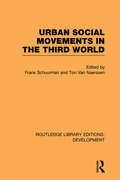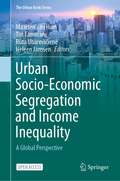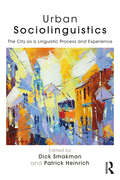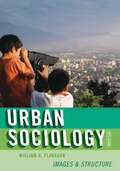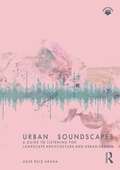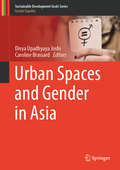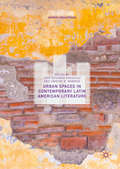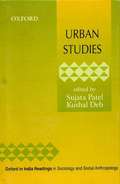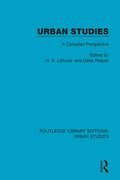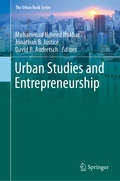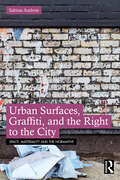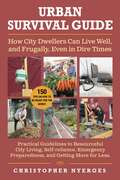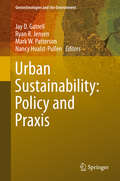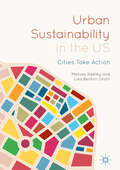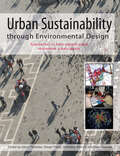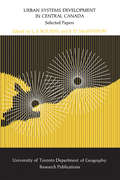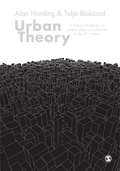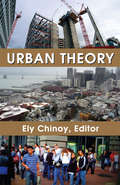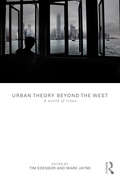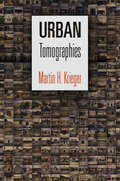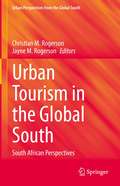- Table View
- List View
Urban Social Movements in the Third World (Routledge Library Editions: Development)
by Frans Schuurman Ton Van NaerssenThis reissue, initially published in 1989, considers the upsurge of locally-based movements attempting to improve living conditions in Third-World cities throughout the 1980s. The book presents qualitative, comparative research on the dynamics and constraints of these urban social movements, in a cross-cultural framework, using case studies from a variety of Latin American, African and Asian countries. As more democratic-type regimes establish themselves in the Third World, the possibilities for collective organisations and actions increase. Urban social movements therefore are playing an increasingly important role in the habitat of the poor.
Urban Socio-Economic Segregation and Income Inequality: A Global Perspective (The Urban Book Series)
by Maarten Van Ham Tiit Tammaru Rūta Ubarevičienė Heleen JanssenThis open access book investigates the link between income inequality and socio-economic residential segregation in 24 large urban regions in Africa, Asia, Australia, Europe, North America, and South America. It offers a unique global overview of segregation trends based on case studies by local author teams. The book shows important global trends in segregation, and proposes a Global Segregation Thesis.Rising inequalities lead to rising levels of socio-economic segregation almost everywhere in the world. Levels of inequality and segregation are higher in cities in lower income countries, but the growth in inequality and segregation is faster in cities in high-income countries. This is causing convergence of segregation trends. Professionalisation of the workforce is leading to changing residential patterns. High-income workers are moving to city centres or to attractive coastal areas and gated communities, while poverty is increasingly suburbanising. As a result, the urban geography of inequality changes faster and is more pronounced than changes in segregation levels. Rising levels of inequality and segregation pose huge challenges for the future social sustainability of cities, as cities are no longer places of opportunities for all.
Urban Sociolinguistics: The City as a Linguistic Process and Experience
by Dick Smakman Patrick HeinrichFrom Los Angeles to Tokyo, Urban Sociolinguistics is a sociolinguistic study of twelve urban settings around the world. Building on William Labov’s famous New York Study, the authors demonstrate how language use in these areas is changing based on belief systems, behavioural norms, day-to-day rituals and linguistic practices. All chapters are written by key figures in sociolinguistics and presents the personal stories of individuals using linguistic means to go about their daily communications, in diverse sociolinguistic systems such as: extremely large urban conurbations like Cairo, Tokyo, and Mexico City smaller settings like Paris and Sydney less urbanised places such as the Western Netherlands Randstad area and Kohima in India. Providing new perspectives on crucial themes such as language choice and language contact, code-switching and mixing, language and identity, language policy and planning and social networks, this is key reading for students and researchers in the areas of multilingualism and super-diversity within sociolinguistics, applied linguistics and urban studies.
Urban Sociology
by Mark AbrahamsonThis concise yet comprehensive overview of the political and economic development of the world's cities offers a unique emphasis on its cultural impacts. The book emphasizes the transition from modern (industrial) to post-modern (post-industrial) eras and its effect on established and developing global cities, and arguments are supported with case studies for each of the main concepts of urban theory and research. Mark Abrahamson analyzes contemporary global cities - ranging from Lagos to Los Angeles, Paris to Beijing - helping students relate concepts to concrete places and understand the global nature of contemporary urban development. Rigorous yet accessible, this textbook includes key learning features designed to enrich student understanding and engagement, including chapter-by-chapter glossaries, summaries, and suggestions for further reading.
Urban Sociology: Images and Structure
by William G. FlanaganThe fifth edition of this text presents a balanced review of the ecological arguments that the urban arena produces unique experiential and urban-based cultural effects while exploring the broader political and economic contexts that produce and modify the urban environment. In addition to examining the urban dimensions of such topics as community formation and continuity, minority and majority dynamics, ethnic experience, poverty, power, and crime, it provides an analysis of the spatial distribution of population and resources with regard to the metropolitanization of the urban form, and the interaction between urban concentration and development and underdevelopment. <p><p>From a first chapter that begins with a discussion of some of the more micrological features of the urban experience, the text focuses on the significance of the more macrological cultural, social organizational, and political dimensions of urban change, in an historical span that includes the first cities and concludes with an exploration of the implications of cyberspace, transnationalism, and global terrorism for the future of urban sociology. While the work focuses primarily on the North American case, its analytical and integrated discussion makes it applicable to urban societies in general.
Urban Soundscapes: A Guide to Listening for Landscape Architecture and Urban Design
by Usue Ruiz AranaSound and listening are intrinsically linked to how we experience and engage with places and communities. This guide puts forward a new conceptual framework of embodied affectivity that emphasises listening in urban research and design and advances new ways of knowing and making. The guide invites landscape architects and urban designers to become soundscape architects and offers practical advice on sound and listening applicable to each stage of a design project: from reading the environment to intervening on it.Urban Soundscapes foregrounds listening as an affective mediator between subjects and multispecies environments, and a vehicle to think and conceptualise environmental research and design beyond prevailing visual and human-centred modes. The guide expands landscape architects’ and urban designers’ tools and skills to assess existing soundscapes, predict how those soundscapes will be altered through their designs, consider sound as a creative and active part of the design process and envisage how users might perceive and be affected by those soundscapes as they evolve in time. The volume sits in the interface of research and practice and interweaves theoretical, methodological and creative contributions from acoustic ecology, ecoacoustics, bioacoustics and sound art. Each of the design stages is illustrated through project examples that demonstrate the many advantages of incorporating attentive listening and sound into Landscape Architecture and Urban Design Practice. This book shows how incorporating listening and sounding as part of the design process promotes slow and subtle ways of practice, adds social and ecological value through the reduction of noise pollution and by monitoring the health of habitats, and enables the design of soundscapes that complement the character and design intent of a scheme and elicit joy and wonder.The book will be of interest to practitioners and academics in landscape architecture, and other design and spatial fields such as urban design, architecture, geography and engineering, who play a primary role in the composition of the soundscape.
Urban Space and National Identity in Early Twentieth Century São Paulo, Brazil: Crafting Modernity
by Cristina Peixoto-MehrtensThis book focuses on how the political, cultural, and technical networks within the field of engineering provided the space within which an important professional middle class prospered in the city of São Paulo and made lasting contributions to the development of modern Brazil.
Urban Spaces and Gender in Asia (Sustainable Development Goals Series)
by Caroline Brassard Divya Upadhyaya JoshiExploring the relationship between place and identity, this book gathers 30 papers that highlight experiences from throughout the Asia-Pacific region. The countries profiled include China, India, Japan, Indonesia, and Thailand. Readers will gain a better understanding of how urbanization is affecting gender equity in Asian-Pacific cities in the 21st century. The contributing authors examine the practical implications of urban development and link them with the broader perspective of urban ecology. They consider how visceral experiences connect with structural and discursive spheres. Further, they investigate how multiple, interconnected relations of power shape gender (in)equity in urban ecologies, and address such issues as construction of Kawaii as an idealized femininity, diversity among homosexuals in urban India, and single women and rental housing. In turn, the authors present hitherto unexplored sub-themes from historiography and existentialist literary perspectives, and share a vast range of multi-disciplinary views on issues concerning gendered dispossession due to the impact of urban policy and governance. The topics covered include socio-spatial and ethnic segregation in urban spaces; intersections of gender, race, ethnicity, nationality, religion, and caste in urban spaces; and identity-based marginalization, including that of LGBT groups. Overall, the book brings together perspectives from the humanities and the social sciences, and represents a valuable contribution to the vital theoretical and practical debates on urbanism and gender equity.
Urban Spaces in Contemporary Latin American Literature (Hispanic Urban Studies)
by José Eduardo González Timothy R. RobbinsThis collection of essays studies the depiction of contemporary urban space in twenty-first century Latin American fiction. The contributors to this volume seek to understand the characteristics that make the representation of the postmodern city in a Latin American context unique. The chapters focus on cities from a wide variety of countries in the region, highlighting the cultural and political effects of neoliberalism and globalization in the contemporary urban scene. Twenty-first century authors share an interest for images of ruins and dystopian landscapes and their view of the damaging effects of the global market in Latin America tends to be pessimistic. As the book demonstrates, however, utopian elements or “spaces of hope” can also be found in these narrations, which suggest the possibility of transforming a capitalist-dominated living space.
Urban Studies
by Kushal Deb Sujata PatelThis is a sociological study of the Indian city and urbanism. It draws from some of the most influential studies conducted on Indian cities and includes conceptual pieces on the making of the urban life in India and a thematic treatment of city life.
Urban Studies: A Canadian Perspective (Routledge Library Editions: Urban Studies)
by N. H. Lithwick and Gilles PaquetThis study, first published in 1968, was one of the first books on Canada’s urban development, bringing together the viewpoints of professionals who had studied various aspects of city growth – economic, social, geographic, political. The book demonstrates the effectiveness and potential of the cross-disciplinary approach and will prove useful to all those interested in the future of our cities.
Urban Studies and Entrepreneurship (The Urban Book Series)
by David B. Audretsch Muhammad Naveed Iftikhar Jonathan B. JusticeThis book attempts to advance critical knowledge and practices for fostering a variety of entrepreneurship at a city level. The book aims to connect scholarship and policy practice in two disciplines: Urban Studies and Entrepreneurship. The book has included contributions from developed, emerging, and developing countries. The chapters are clubbed under five main sections; I. Startups and Entrepreneurial Opportunities, II. Knowledge Spillover, III. Social and Bureaucratic Entrepreneurialism, IV. Demography and Informal Entrepreneurs V. Perspectives from Emerging and Developing Economies.In this regard, the book explores a number of questions, such as: what are the important varieties of entrepreneurship, how can they be observed and measured, and how does each variety emerge and operate under various conditions of infrastructure and opportunity? Which type(s) of entrepreneurship should a city prefer? What can cities do to stimulate desirable forms of entrepreneurship or is it more of a spontaneous phenomenon? Why do policies that enhance entrepreneurship in some contexts seem instead to promote crony capitalism and rent-seeking in other contexts? Should cities focus on growing their own entrepreneurs and entrepreneurial enterprises or on luring them from other cities and countries? How can a collective action in a city promote (or hinder) entrepreneurship? The contributions in the present volume address head-on these questions at the intersection of urban studies, economic theory, and the practicalities of economic development and urban governance, in a genuinely global range of places and applications.
Urban Surfaces, Graffiti, and the Right to the City (ISSN)
by Sabina AndronThis book explores the ownersheir authorship and management, and their role in struggles for the right to the city. Includes a critical history of graffiti and street art as contested surface discourses. Interdisciplinary appeal.
Urban Survival Guide: How City Dwellers Can Live Well, and Frugally, Even in Dire Times
by Christopher NyergesPractical Guidelines to Resourceful City Living, Self-reliance, Emergency Preparedness, and Getting More for Less A survival guidebook that reflects the world in which we now find ourselves. The post 9/11 world seems a bit more hostile, as terrorist threats and attacks are no longer a surprise. The Great Tsunami of Christmas 2004 showed us that quick extinctions (like Noah&’s flood) can and do happen without apparent warning. Hurricanes Katrina and Sandy not only told us that it can happen to us, but that it is foolhardy to make no preparations and pretend that the government will take care of you in the post-disaster landscape. The price of gold id rising again. War, rumors of war, famines, political instability, economic instability, global pandemics – all these and more are causes of concern to the average family. Economic survival is also addresses, since this is such a fundamental building block of everything else in modern society. Money cannot be ignored.
Urban Sustainability: Policy and Praxis
by Jay D. Gatrell Ryan R. Jensen Mark W. Patterson Nancy Hoalst-PullenThis book explores the environmental, economic, and socio-political dynamics of sustainability from a geographic perspective. The chapters unite the often disparate worlds of environment, economics, and politics by seeking to understand and visualize a range of sustainability practices on the ground and in place. In concert, the book provides an overview of a range of geotechnical applications associated with environmental change (water resources, land use & land cover change); as well as investigates more nuanced and novel examples of local economic development in cities. The diverse collection maps local practices from urban farming to evolving and thriving industries such as metal scrapping and craft beer. Additionally, the book provides an integrated geo-technical framework for understanding and assessing ecosystem services, explores the deployment of unmanned systems to understand urban environmental change, interrogates the spatial politics of urban green movements, examines the implications of revised planning practices, and investigates environmental justice. The book will be of interest to researchers, students, and anyone seeking to better understand sustainability at multiple scales in urban environments.
Urban Sustainability in the US: Cities Take Action
by Lisa Benton-Short Melissa KeeleyCities are stepping forward to address the critical sustainability challenges of the 21st century. Meeting the demands of complex issues requires municipalities to evaluate problems and their solutions in more holistic, integrated, and collaborative ways. Drawn from plans and progress reports from more than fifty US cities, this book examines how urban leaders conceptualize sustainability, plan effective strategies, and take action. Chapters examine various topical themes including equity, the green economy, climate change, energy, transportation, water, green space, and waste. Throughout the text, the authors highlight best practices in innovative solutions, recognizing the multiple benefits of sustainability projects, environmental justice, governance, education and communication.
Urban Sustainability Through Environmental Design: Approaches to Time-People-Place Responsive Urban Spaces
by Kevin Thwaites Sergio Porta Ombretta Romice Mark GreavesWhat can architects, landscape architects and urban designers do to make urban open spaces, streets and squares, more responsive, lively and safe? Urban Sustainability through Environmental Design answers this question by providing the analytical tools and practical methodologies that can be employed for sustainable solutions to the design and management of urban environments. The book calls into question the capability of ‘quick-fix’ development solutions to provide the establishment of fixed communities and suggests a more time-conscious and evolutionary approach. This is the first significant book to draw together a pan-European view on sustainable urban design with a specific focus on social sustainability. It presents an innovative approach that focuses on the tools of urban analysis rather than the interventions themselves. With its practical approach and wide-ranging discussion, this book will appeal to all those involved in producing communities and spaces for sustainable living, from students to academics through to decision makers and professional leaders.
Urban Systems Development in Central Canada
by Ross D. Mackinnon L. S. BourneThis anthology of research is divided into five sections: definition of the urban system, structural characteristics, distribution of urban growth, transportation networks and interaction between cities, and the impact of growth on urban behaviour and the rural economy. Each section is preceded by the editors' comments. This is an excellent general reference on urbanization in Canada; it complements existing and largely American-based texts and should stimulate the student's interest in research on the unique Canadian urban milieu.(Department of Geography Research Publication 9)
Urban Theory: A critical introduction to power, cities and urbanism in the 21st century
by Talja Blokland Alan HardingWhat is Urban Theory? How can it be used to understand our urban experiences? Experiences typically defined by enormous inequalities, not just between cities but within cities, in an increasingly interconnected and globalised world. This book explains: Relations between urban theory and modernity - the foundational concept in urban studies - in key ideas of the Chicago School, in spatial analysis, humanistic urban geography, and 'radical' approaches like Marxism Cities and the transition from industrial to informational economies, globalization, the importance of urban growth machine and urban regime theory, the city as an "actor" Spatial expressions of inequality - understood horizontally and vertically - and key ideas like segregation, ghettoization, suburbanization, gentrification, and "neighbourhood effects" Socio-cultural spatial expressions of difference and key concepts like gender, sexuality, race, ethnicity, age, public space; "culturalist" perspectives on identity, lifestyle, subculture How cities should be understood as intersections of horizontal and vertical - of coinciding resources, positions, locations; of different constellations of race, class, gender, ethnicity, sexuality, and age, influencing how we make and understand urban experiences. Critical, interdisciplinary and pedagogically informed - with opening summaries, boxes, questions for discussion and guided further reading - Urban Theory: A Critical Introduction to Power, Cities and Urbanism in the 21st Century provides the tools for any student of the city to understand, even to change, our own urban experiences.
Urban Theory
by Ely ChinoyWhat is the future of the American city? What are the relevant contexts for the analysis of urban problems? Should attention be focused on the metropolitan area, the region, or the megalopolis? Does the changing shape and structure of urban America require new ways of thinking about the urban community? How do national trends and policies affect the future of city life? Until now few sociologists have tried to see what urban America may become. This failure limits their ability to serve the function they claim for themselves, asserts Ely Chinoy, enabling men and women to help shape their own future.Urban Theory examines trends, including social, cultural, and national variables that could affect them; offers explanations of urban problems; and presents a careful review of solutions that have been offered - proposals of planners, politicians, cynics, and even visionaries for remaking our cities and for controlling and directing growth or deterioration. It is a valuable assessment of the state of thinking about urban life during the post-World War II period, with interesting projections of trends and analyses. It includes a comprehensive discussion of many of the more academic questions dealt with in courses in urban sociology and urban planning, as well as a treatment of problems within a larger and more meaningful context.Chinoy states that unless people anticipate alternatives open to them, they will remain captive to forces that they do not understand or have no control over. By examining what the future may hold, we can more readily understand the present, cope with its problems, and deliberately contribute to the shape of the future. This perspective is as appropriate today as it was when the book was originally published in 1973. Included here are pieces by York Willbern, Catherine Bauer Wurster, John Friedman, John Miller, Jean Gottman, Paul N. Ylvisaker, Nathan Glazer, Morton Grodzins, and Russell Baker. This material will continue to be of interest in all sociology, political science, and urban studies courses that deal with crucial problems of the city, as well as to all planners and urban specialists.
Urban Theory: A critical introduction to power, cities and urbanism in the 21st century
by Alan Harding Talja BloklandWhat is Urban Theory? How can it be used to understand our urban experiences? Experiences typically defined by enormous inequalities, not just between cities but within cities, in an increasingly interconnected and globalised world. This book explains: Relations between urban theory and modernity in key ideas of the Chicago School, spatial analysis, humanistic urban geography, and ‘radical' approaches like Marxism Cities and the transition to informational economies, globalization, urban growth machine and urban regime theory, the city as an “actor” Spatial expressions of inequality and key ideas like segregation, ghettoization, suburbanization, gentrification Socio-cultural spatial expressions of difference and key concepts like gender, sexuality, race, ethnicity and “culturalist” perspectives on identity, lifestyle, subculture How cities should be understood as intersections of horizontal and vertical – of coinciding resources, positions, locations, influencing how we make and understand urban experiences. Critical, interdisciplinary and pedagogically informed - with opening summaries, boxes, questions for discussion and guided further reading - Urban Theory: A Critical Introduction to Power, Cities and Urbanism in the 21st Century provides the tools for any student of the city to understand, even to change, our own urban experiences.
Urban Theory: New critical perspectives
by Mark Jayne Kevin WardUrban Theory: New Critical Perspectives provides an introduction to innovative critical contributions to the field of urban studies. Chapters offer easily accessible and digestible reviews, and as a reference text Urban Theory is a comprehensive and integrated primer which covers topics necessary for a full understanding of recent theoretical engagements with cities. The introduction outlines the development of urban theory over the past two hundred years and discusses significant theoretical, methodological and empirical challenges facing the field of urban studies in the context of an increasing globally inter-connected world. The chapters explore twenty-four topics, which are new additions to the urban theoretical debate, highlighting their relationship to long established concerns that continue to have intellectual purchase, and which also engage with rich new and emerging avenues for debate. Each chapter considers the genealogy of the topic at hand and also includes case studies which explain key terms or provide empirical examples to guide the reader to a better understanding of how theory adds to our understanding of the complexities of urban life. This book offers a critical and assessable introduction to original and groundbreaking urban theory and will be essential reading for undergraduate and postgraduate students in human geography, sociology, anthropology, cultural studies, economics, planning, political science and urban studies.
Urban Theory Beyond the West: A World of Cities
by Tim Edensor Mark JayneSince the late eighteenth century, academic engagement with political, economic, social, cultural and spatial changes in our cities has been dominated by theoretical frameworks crafted with reference to just a small number of cities. This book offers an important antidote to the continuing focus of urban studies on cities in ‘the Global North’. Urban Theory Beyond the West contains twenty chapters from leading scholars, raising important theoretical issues about cities throughout the world. Past and current conceptual developments are reviewed and organized into four parts: ‘De-centring the City’ offers critical perspectives on re-imagining urban theoretical debates through consideration of the diversity and heterogeneity of city life; ‘Order/Disorder’ focuses on the political, physical and everyday ways in which cities are regulated and used in ways that confound this ordering; ‘Mobilities’ explores the movements of people, ideas and policy in cities and between them and ‘Imaginaries’ investigates how urbanity is differently perceived and experienced. There are three kinds of chapters published in this volume: theories generated about urbanity ‘beyond the West’; critiques, reworking or refining of ‘Western’ urban theory based upon conceptual reflection about cities from around the world and hybrid approaches that develop both of these perspectives. Urban Theory Beyond the West offers a critical and accessible review of theoretical developments, providing an original and groundbreaking contribution to urban theory. It is essential reading for students and practitioners interested in urban studies, development studies and geography.
Urban Tomographies (The City in the Twenty-First Century)
by Martin H. KriegerTomography is a method of exploring a phenomenon through a large number of examples or perspectives. In medical tomography, such as a CAT scan, two-dimensional slices or images of a three-dimensional organ are used to envision the organ itself. Urban tomography applies the same approach to the study of city life. To appreciate different aspects of a community, from infrastructure to work to worship, urban planning expert Martin H. Krieger scans the myriad sights and sounds of contemporary Los Angeles. He examines these slices of life in Urban Tomographies.The book begins by introducing tomographic methods and the principles behind them, which are taken from phenomenological philosophy. It draws from the examples of Lee Friedlander and Walker Evans, as well as Denis Diderot, Charles Marville, and Eugène Atget, who documented the many facets of Paris life in three crucial periods. Rather than focus on singular, extraordinary figures and events as do most documentarians, Krieger looks instead at the typical, presenting multiple specific images that call attention to people and activities usually rendered invisible by commonality. He took tens of thousands of photographs of industrial sites, markets, electrical distributing stations, and storefront churches throughout Los Angeles. He also recorded the city's ambient sounds, from the calls of a tamale vendor to the buzz of a workshop saw. Krieger considers these samples from the urban sensorium in this innovative volume, resulting in a thoughtful illumination of the interplay of people with and within the built environment. With numerous maps and photographs, as well as Krieger's unique insights, Urban Tomographies provides an unusually representative and rounded view of the city.
Urban Tourism in the Global South: South African Perspectives (GeoJournal Library)
by Christian M. Rogerson Jayne M. RogersonThis book examines and addresses the particular character of urban tourism occurring in the global South. It presents research essays on tourism in urban areas of South Africa, a country which is associated with big 5 nature tourism but where urban areas are also major tourism destinations. The book contextualizes urban tourism in South Africa as part of ‘the other half of urban tourism’, an overlooked but energetic scholarship which is emerging on urban places in the global South. The volume moves to present a collection of original material variously on national perspectives on urban tourism following by a cluster of city level perspectives. The last three contributions turn to the role of tourism in small towns, the bottom rung in the urban settlement system. Issues of concern include gastronomic tourism, VFR travel, airportscapes, climate change, AirBnb and creative tourism. Finally, as COVID-19 is potentially a defining historical moment for urban tourism, the volume incorporates historical research perspectives in order to address the overwhelming ‘present-mindedness’ of mainstream urban tourism writings. The book highlights the challenges and opportunities for tourism development in the environment of the urban global South and is relevant to scholars of both tourism and urban studies as well as researchers in development studies.
